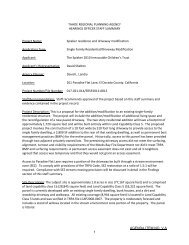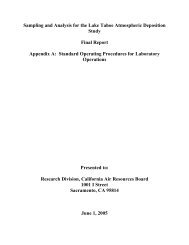FEIS - Tahoe Regional Planning Agency
FEIS - Tahoe Regional Planning Agency
FEIS - Tahoe Regional Planning Agency
Create successful ePaper yourself
Turn your PDF publications into a flip-book with our unique Google optimized e-Paper software.
RESPONSE TO COMMENTS ON THE DEIS<br />
B o u l d e r B a y C o m m u n i t y E n h a n c e m e n t P r o g r a m P r o j e c t E I S<br />
stormwater treatment systems (E20), Alt C with 20yr/1hr stormwater treatment<br />
systems (C20), and Alt C with 100yr/1hr stormwater treatment systems (C100) are<br />
reported for a variety of water year conditions.<br />
Comment 137-d: Comment Summary - Alternatives C and D rely on subsurface infiltration galleries<br />
and the DEIS fails to evaluate: 1) loss of gallery efficiency over time due to trash,<br />
sediment, organic matter, 2) the cost of maintaining galleries, and 3) Visual<br />
inspection of the galleries is inadequate to determine operating efficiency. In<br />
addition, there is no comparative analysis of above-ground infiltration galleries.<br />
a) Long-term performance of any stormwater treatment system is reliant on the<br />
inspections, operations and maintenance of the system. The loss of efficiency over<br />
time will be minimized through proper operations and maintenance as determined in<br />
the Inspection, Maintenance and Monitoring Plan (SP-10) required for permitting of<br />
the selected Alternative. The supplemental analysis does consider the loss of gallery<br />
efficiency due to antecedent moisture in the system. The Inspection, Maintenance<br />
and Monitoring Plan is a standard practice of the Project (added as SP-10 in Chapter<br />
6). The Plan will be developed for the selected Alternative through an RFP Process<br />
that includes a third party agreement between TRPA, Boulder Bay and a consultant.<br />
This detailed plan will be based on Chapter 6 of the EIS but can be tailored to the<br />
outcome of the Governing Board hearings that will decide the final design of the<br />
Project, if approved. b) Because some of the facilities are subsurface, access points<br />
are built into the linear treatment system for maintenance and monitoring. The costs<br />
associated with maintenance and monitoring will be determined during project<br />
permitting because these costs are directly related to the selected Alternative.<br />
Although Boulder Bay will be committed to proper maintenance as a conditions of<br />
project permitting, the EIS recommends mitigation measure HYDRO-1 to assure that<br />
stormwater treatment systems are operated and maintained to be effective in meeting<br />
TRPA discharge standards. c) The comment that BMP inspections will only be<br />
visually based is incorrect, and the reference to DEIS Appendix G is in error.<br />
Appendix G provides the narrative explaining the stormwater treatment system<br />
design and routing along with the supporting calculations for summary tables 4.3-5 to<br />
4.3-12. The post project monitoring program will be finalized in accordance with the<br />
permitting conditions for the selected Alternative and will most likely include some<br />
level of stormwater monitoring in addition to BMP and treatment system inspections.<br />
Referencing DEIS Appendix G, the "galleries are designed linearly so that if it occurs<br />
that an upstream gallery is clogged or overburdened, the additional capacity in the<br />
downstream galleries will absorb some of the overflow". The commenter states that<br />
above-grade drainage infiltration galleries are easier to inspect and maintain but<br />
provides no supportive data or references. The commenter states that the stormwater<br />
treatment system is entirely underground, which is incorrect. The proposed<br />
stormwater treatment systems combine infiltration trenches, infiltration galleries<br />
(underground) and infiltration basins (above ground) to maximize the capture<br />
potential of the project area and increase capacity of the systems.<br />
Comment 137-e: Comment Summary - The DEIS needs to provide more information regarding the<br />
pervious pavers in Alternative C and discuss their applicability, potential for success,<br />
and ability to absorb runoff. UC Davis states they should not be used if surface<br />
grade exceeds 5%. How effective are they beyond 5% grade? How will snow<br />
removal affect pavers? Discuss where they will be used, the type to be used, and<br />
whether they are suitable. Evaluate improper maintenance of pavers.<br />
PAGE 8- 54 HAUGE BRUECK ASSOCIATES SEPTEMBER 8 , 2010






